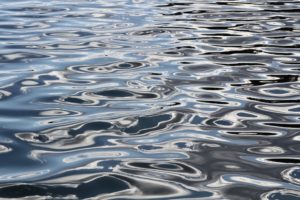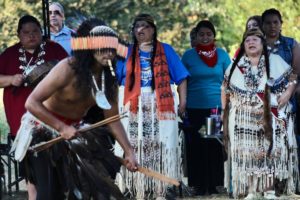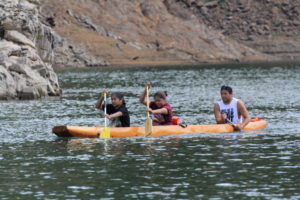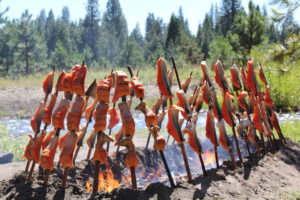Salmon People
 Gazing at the surface of a river or ocean our human eyes are blind to the life that thrives in those sacred waters. Nor can we see how few salmon today swim up California’s rivers to spawn in the high country streams they’ve visited for millennia. Where once there were millions now there are thousands.
Gazing at the surface of a river or ocean our human eyes are blind to the life that thrives in those sacred waters. Nor can we see how few salmon today swim up California’s rivers to spawn in the high country streams they’ve visited for millennia. Where once there were millions now there are thousands.
Winnemem Wintu Chief Caleen Sisk has pondered this enigma for decades and prayed for answers that might wake people up to the plight of both water and salmon—and our shared responsibility to take better care of them. According to the Winnemem creation story, salmon took pity on the first humans and offered to give people the power of speech if the humans promised always to speak for the salmon. Winnemem ancestors said “yes.”
Caleen takes that obligation seriously and with Mauna Kea protector Pua Case, minstrel Nahko Bear, activist Winona LaDuke, Ohlone leader Corrina Gould and others, a 300-mile prayerful journey that links the people to the salmon has emerged and flowered. For two weeks, we walk, run, bike, canoe, horseback ride and swim up and up and up alongside the fish. Weak and postmodern, we humans sometimes hitch rides in cars, trucks and motorboats as well.
And so on September 9, the hundred people who gathered for the opening ceremony of this year’s Run4Salmon looked down at the shimmering Carquinez Strait, where the Sacramento River emerges from the West Coast’s largest estuary in the delta to merge with San Francisco Bay. We all wondered how many winter run Chinook salmon were making their way past us on their way toward Mt. Shasta’s cold, melting waters.
 As the sun set, a pounding drum sent vibrations through earth to water’s edge, calling the salmon and encouraging them onward. Winnemem dancers swayed like swimmers around a radiant fire. Singers urged dancers and salmon on. Ohlone leader Corrina Gould shared the history of Sogorea Te, the Ohlone village site that hosts the opening ceremony, and said, “The salmon that came up our rivers and took care of my ancestors are the same salmon that spawn in Chief Sisk’s river and took care of her ancestors.”
As the sun set, a pounding drum sent vibrations through earth to water’s edge, calling the salmon and encouraging them onward. Winnemem dancers swayed like swimmers around a radiant fire. Singers urged dancers and salmon on. Ohlone leader Corrina Gould shared the history of Sogorea Te, the Ohlone village site that hosts the opening ceremony, and said, “The salmon that came up our rivers and took care of my ancestors are the same salmon that spawn in Chief Sisk’s river and took care of her ancestors.”
Together, Caleen and Corrina are bringing the lessons of Standing Rock home, giving hope as protectors not protestors, affirming their cultural obligations to history, land and water. The Winnemem have launched a GoFundMe campaign to help them bring back salmon from New Zealand — where fertilized eggs from their river were shipped in 1873 — and to build a swimway around Shasta Dam so winter run Chinook can once again spawn in the McCloud River.
At the closing ceremony on September 22, Caleen sang a flotilla of canoes in to land on the banks of the McCloud River. Nahko Bear rode in on horseback with a half dozen pilgrims. The circle was complete.
 Caleen stood at the fire and closed out a transformative two-week ceremony: “Our tribe has an ancient prophecy, ‘When there are no more salmon, there will be no more Winnemem Wintu people.’ For this reason, we believe we must do everything we can to bring back our salmon. This is our Dakota Access Pipeline: we have to wake the people up before we are standing in front of bulldozers—and we’ll do that too if we have to.”
Caleen stood at the fire and closed out a transformative two-week ceremony: “Our tribe has an ancient prophecy, ‘When there are no more salmon, there will be no more Winnemem Wintu people.’ For this reason, we believe we must do everything we can to bring back our salmon. This is our Dakota Access Pipeline: we have to wake the people up before we are standing in front of bulldozers—and we’ll do that too if we have to.”
Check out my photo gallery of images from two years of Run4Salmon.
 Some Resources and Additional Information:
Some Resources and Additional Information:
This year, Sacred Land Film Project writer Jessica Abbe and others produced a terrific 4th grade curriculum to bring Run4Salmon into classrooms. Please share with teachers you know.
My daughter, Fiona McLeod, was an intern at Women’s Earth Alliance this summer and posted three great blogs on Run4Salmon: Part 1 on Salmon, Part 2 on the Winnemem, and Part 3 on Women Leaders.
See Marc Dadigan’s excellent report on Run4Salmon 2017 in Yes Magazine.
Caleen Sisk and Gary Mulcahy wrote a wonderful piece on salmon for KCET-TV’s website: “When Salmon Speak.” Please check it out.
Visit the Run4Salmon website and Facebook page.
Blog Post Categories: North America, Threatened Sacred Sites, Water, Winnemem Wintu